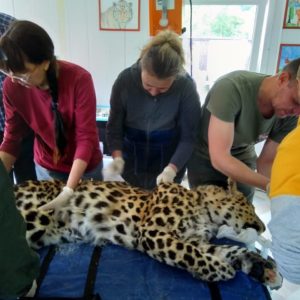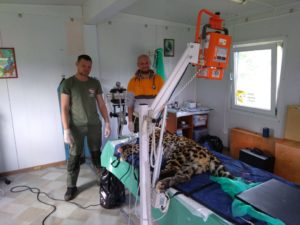It is still a rare occurrence that wild Amur leopards come into the care of humans, but when they do they go to PRNCO ‘Tiger Center’ to receive any veterinary care they may need before rehabilitation and hopeful release back to the wild. In recent years only two leopards have gone to the centre. Unfortunately the first died within a few days in what was the first ever recorded case of Canine Distemper Virus in Amur leopards – a disease which can have catastrophic effects on big cat populations.
The second leopard was found with an injured front paw after being caught in a snare. He stayed at the centre for several months but because of ongoing issues with his paw it was decided that it was too risky for him to be released back to the wild. It was likely that his compromised hunting ability could lead to him relying on taking easier prey such as domestic livestock which could bring him into a conflict situation. It was therefore decided that ‘Nikolay’ should join the zoo population and he is currently living at Moscow Zoo’s breeding centre where he has successfully sired two male cubs, making a hugely important genetic contribution to the zoo population.

© PRNCO Tiger Center
Now though there is another leopard being cared for at the centre, Leo 131M. He was found on 3rd March on the border of Land of the Leopard National Park in a very poor condition. He had sustained many severe bite wounds from a similar sized animal so it is thought that he may have been in a fight with another male Amur leopard. However, given the severity of his wounds, which included a broken hind left paw, it is possible that he was already in a compromised state when the fight occurred and had possibly been hit by a car before the fight. It is estimated he was about 2.5 years old when found, and he has not been recorded before on cameratrap images.
For the first two months at the centre he was kept in a quarantine area which enabled him to be monitored closely and to be given the medication he needed regularly – painkillers and antibiotics. He also had a number of examinations under anaesthetic to treat his wounds which responded well.

© PRNCO Tiger Center
On 6th May, he was moved to one of the large rehabilitation enclosures so he could begin regaining his hunting skills. He has now started hunting small live prey successfully and most of his wounds have healed, including the large one on his back. His fractured paw has healed but there is still some muscle atrophy in his leg causing him to limp. At present it is not known what is causing this so he will still be closely monitored and treatment given where appropriate. It is too soon to say whether he will recover enough to be released back to the wild but he is receiving the best care possible and we keep our fingers crossed for him!

